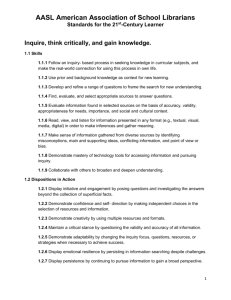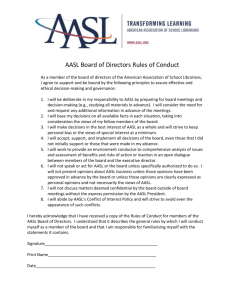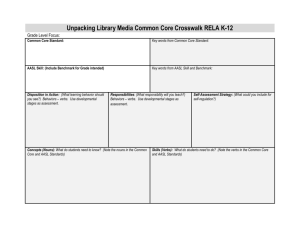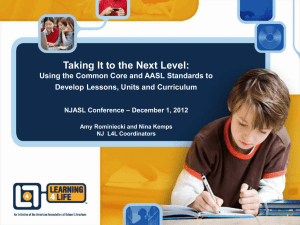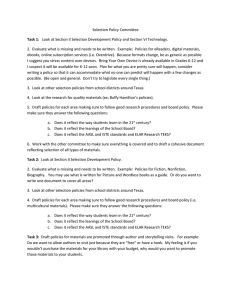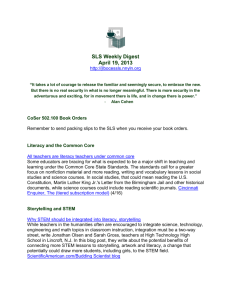Common Core Lesson Planning Resources AASL Learning
advertisement
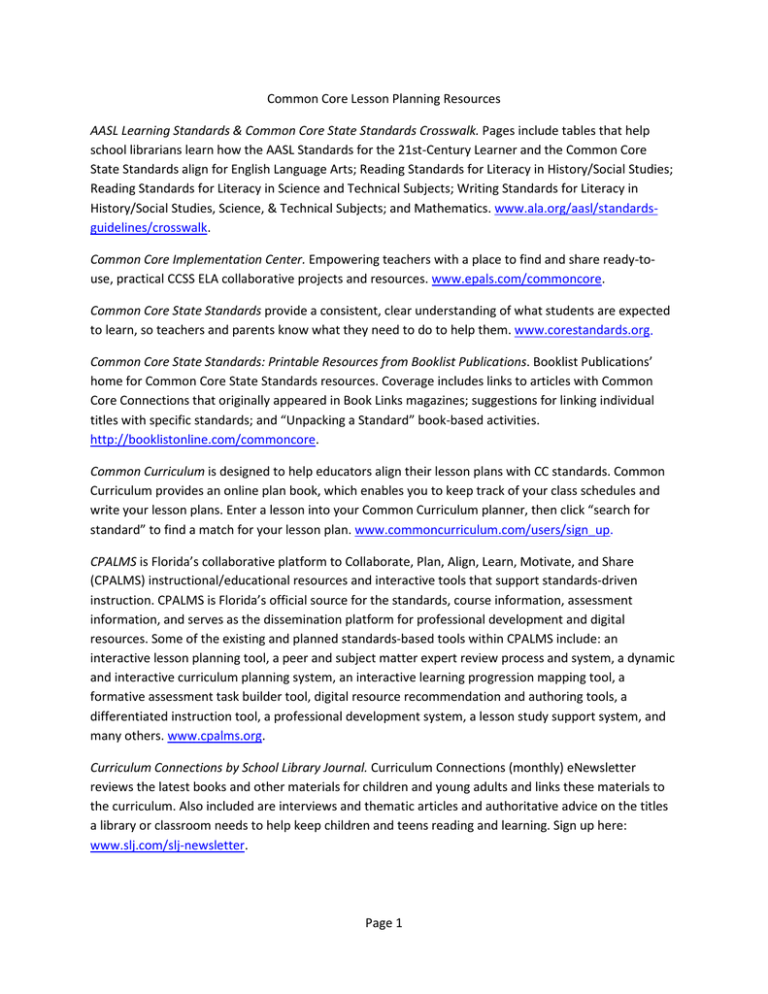
Common Core Lesson Planning Resources AASL Learning Standards & Common Core State Standards Crosswalk. Pages include tables that help school librarians learn how the AASL Standards for the 21st-Century Learner and the Common Core State Standards align for English Language Arts; Reading Standards for Literacy in History/Social Studies; Reading Standards for Literacy in Science and Technical Subjects; Writing Standards for Literacy in History/Social Studies, Science, & Technical Subjects; and Mathematics. www.ala.org/aasl/standardsguidelines/crosswalk. Common Core Implementation Center. Empowering teachers with a place to find and share ready-touse, practical CCSS ELA collaborative projects and resources. www.epals.com/commoncore. Common Core State Standards provide a consistent, clear understanding of what students are expected to learn, so teachers and parents know what they need to do to help them. www.corestandards.org. Common Core State Standards: Printable Resources from Booklist Publications. Booklist Publications’ home for Common Core State Standards resources. Coverage includes links to articles with Common Core Connections that originally appeared in Book Links magazines; suggestions for linking individual titles with specific standards; and “Unpacking a Standard” book-based activities. http://booklistonline.com/commoncore. Common Curriculum is designed to help educators align their lesson plans with CC standards. Common Curriculum provides an online plan book, which enables you to keep track of your class schedules and write your lesson plans. Enter a lesson into your Common Curriculum planner, then click “search for standard” to find a match for your lesson plan. www.commoncurriculum.com/users/sign_up. CPALMS is Florida’s collaborative platform to Collaborate, Plan, Align, Learn, Motivate, and Share (CPALMS) instructional/educational resources and interactive tools that support standards-driven instruction. CPALMS is Florida’s official source for the standards, course information, assessment information, and serves as the dissemination platform for professional development and digital resources. Some of the existing and planned standards-based tools within CPALMS include: an interactive lesson planning tool, a peer and subject matter expert review process and system, a dynamic and interactive curriculum planning system, an interactive learning progression mapping tool, a formative assessment task builder tool, digital resource recommendation and authoring tools, a differentiated instruction tool, a professional development system, a lesson study support system, and many others. www.cpalms.org. Curriculum Connections by School Library Journal. Curriculum Connections (monthly) eNewsletter reviews the latest books and other materials for children and young adults and links these materials to the curriculum. Also included are interviews and thematic articles and authoritative advice on the titles a library or classroom needs to help keep children and teens reading and learning. Sign up here: www.slj.com/slj-newsletter. Page 1 Discovery Education Pacing Guides contain Common Core curriculum-aligned resources for Discovery Education for English Language Arts, Math, and Science. www.santarosa.k12.fl.us/pg. Discovery Education Streaming provides engaging rich media across all curriculum areas. Designed to support multiple learning modalities with content that is easy to integrate, aligned to standards, and always current. http://streaming.discoveryeducation.com. Florida Memory Classroom. The Online Classroom is designed to help educators use photographs, documents, sound recordings and film footage from the State Library and Archives of Florida. Includes educational units and lesson plans with CCSS correlation in the newer units. www.floridamemory.com/onlineclassroom. From the Creative Minds of 21st Century Librarians. From Syracuse University School of Information Studies. From the Creative Minds of 21st Century Librarians is Center for Digital Literacy’s first e-book project made possible in part through an IMLS grant awarded to CDL in 2008 to update the AASL standards in the S.O.S. for Information Literacy database. This 275-page free downloadable resource contains dozens of lesson plans that implement AASL’s Standards for the 21st-Century Learner in the context of the curriculum. Contributing authors include more than 30 teacher-librarians. If you are looking for creative ideas that target the standards to implement in your school library, this book will help you jumpstart the process. Download the publication here: http://digitalliteracy.syr.edu/page/view/221. HotChalk’s Lesson Plans Page contains over 4,000 relevant lesson plans, created by teachers, proven in the classroom, and absolutely, positively, completely… free! Choose from a wide range of subjectspecific plans, available for all grade levels. http://lessonplanspage.com. The Learning Network: The New York Times. A wealth of diverse resources on current topics using materials from the newspaper and online sources are provided at this site for grades 6-12. http://learning.blogs.nytimes.com. Learning Standards & Program Guidelines Implementation Toolkit. By focusing on small segments, this toolkit is designed to help building level school librarians implement the new AASL learning standards and program guidelines in their school library. http://www.ala.org/aasl/advocacy/tools/toolkits/standards-guidelines. PBS Teachers. Public Broadcasting System. Resources for K-12 are available on various content areas including valuable teaching materials (e.g. timeline of immigration to the U. S.). www.pbs.org/teachers. A Primary Grade Science Unit Using the Language Arts/Literacy Common Core State Standards by Lesley Mandel Morrow. April/May 2012 Reading Today. www.reading.org/Libraries/resources/RTy295CommonCoreCover.pdf. Page 2 ReadWorks. This site provides lesson plans based on read-aloud books for K-4 and novel units for grades 5-6. It also offers nearly 1,000 Lexiled nonfiction passages for grades K-12 searchable by grade, skill/strategy, and keyword. Some passages have worksheets included. Free registration is required to access materials. www.readworks.org. ReadWriteThink Lesson Plans. International Reading Association and National Council of Teachers of English. Includes hundreds of standards-based lesson plans written and reviewed by educators using current research and the best instructional practices. http://www.readwritethink.org/classroomresources/lesson-plans/ Standards for the 21st-Century Learner. Offers vision for teaching and learning to both guide and beckon our profession as education leaders. Skills, dispositions in action, responsibilities, and self-assessment strategies are designed as a tool to help school librarians shape the library program and curriculum, and to mold student learning more broadly. Visit http://www.ala.org/aasl/standards-guidelines/learningstandards. Standards for the 21st-Century Learner Lesson Plan Database. This American Association of School Librarians' (AASL) tool supports school librarians and other educators in teaching the essential learning skills defined in the AASL Standards for the 21st-Century Learner. Lessons submitted as part of the Standards for the 21st-Century Learner Lesson Plan Database contain an automatic crosswalk between AASL learning standards and the Common Core State Standards. To register and begin using the Lesson Plan Database, visit http://aasl.jesandco.org. Thinkfinity is the Verizon Foundation’s free online professional learning community, providing access to over 60,000 educators and experts in curriculum enhancement, along with thousands of award-winning digital resources for K-12 — aligned to state standards and the common core. Here, educators connect and collaborate through themed groups, blogs and discussions, sharing resources and best practices that support 21st century teaching and learning. http://thinkfinity.org. Page 3 General Teaching Resources 4Teachers (www.4teachers.org) works to help teachers integrate technology into the classroom by offering online tools and resources, such as ready-to-use Web lessons, quizzes, rubrics and classroom calendars. A to Z Teacher Stuff (http://atozteacherstuff.com) is a teacher-created site designed to help teachers find online resources more quickly and easily. Find lesson plans, thematic units, teacher tips, discussion forums for teachers, downloadable teaching materials & eBooks, printable worksheets and blacklines, emergent reader books, themes, and more. Education World (www.education-world.com) includes original content, including lesson plans; practical information for educators; information on how to integrate technology in the classroom; and articles written by education experts. Federal Resources for Educational Excellence (FREE) (www.free.ed.gov) includes more than 1,500 federally supported teaching and learning resources from dozens of federal agencies. New sites are added regularly. GlobalSchoolNet (www.globalschoolnet.org) connects students in 194 countries in a worldwide approach to problem solving, project-based learning, and online collaboration. The materials for teachers of all ages will connect your classroom to the world. Teacher Planet (www.teacherplanet.com) has a huge collection of links, resources, lesson plans, templates, rubrics, worksheets and more. The resources are sorted by subject and type. Many resources are links to external sites. TeachersFirst (www.teachersfirst.com) is a rich collection of lessons, units, and web resources designed to save teachers time by delivering just what they need in a practical, user-friendly, and ad-free format. Teachnology (www.teach-nology.com) provides free and easy to use resources for teachers dedicated to improving the education of today's generation of students. It features 46,000+ lesson plans, 10,200 free printable worksheets, rubrics, teaching tips, worksheet makers, web quests, math worksheets, and thousands of other great teacher resources. It is an online teacher resource that is designed to help busy kindergarten through high school teachers. Teaching Channel (www.teachingchannel.org) is a video showcase of innovative and effective teaching practices in America's schools. Page 4
